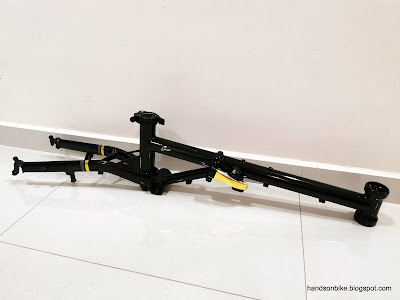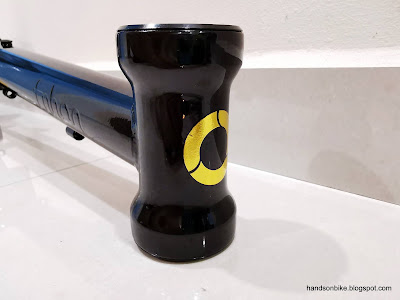My proposed setup would use the existing
Dura-Ace FC-R9100 50/34T crankset, with a SLX CS-M7000 11-40T cassette. This is intended to be on the gravel wheelset, for a wider gear range than the current 11-34T cassette. Officially, there is no rear derailleur that can support such a wide range, as the chain capacity required for this setup is 16 + 29 = 45T, which requires a very long cage.
Based on the hybrid version of the GRX Di2 RD-RX817, with the RD-M8000 SGS cage, the chain capacity has theoretically been increased to 47T. Theoretically it should work...
However, I have another requirement, which is to
use the same rear derailleur and chain, for both the road and gravel setup. The road wheelset has a much smaller 11-30T cassette, compared to the proposed 11-40T cassette for the gravel wheelset. Based on my requirement, there should be no adjustment of the rear derailleur during wheelset swap. There is a big 10T sprocket size difference between the low gear of these two cassettes, so I am not so confident that it would work.
Before showing the results of the rear derailleur testing, let's take a closer look at this SLX CS-M7000 11-40T cassette.
Previous generation of SLX, with 11 speeds. This cassette has a gear combination of 11-40T. There are bigger ones such as 11-42T and 11-46T.
Pretty weighty compared to road cassettes, which are just 200+ grams. The
HG800 11-34T cassette is 337 grams.
Many people think that going from a front double to a front single setup will save weight, but it is often not true, especially if your existing front double drivetrain is a lightweight one.
A basic equation, if you want to have weight reduction when converting from 2x to 1x on a road or gravel bike, is to make sure that the weight of removed front derailleur + second chain ring is more than the additional weight of the cassette. Many times, the larger cassette adds so much weight that the savings from removing the front derailleur and chain ring are totally cancelled off.
Exploded view of the CS-M7000 11-40T cassette. Only the last 3 sprockets are mounted on an aluminium spider.
The spider has a unique design, with 7 arms instead of the more common 6 or 8 arms.
Largest 40T sprocket is aluminium, while the next two 35T and 31T sprockets are just using normal steel.
There is a spider shaped spacer on this sprocket, to better support the sprocket during sideway bending loads.
Objective:
Find a Di2 RD that can cater to both 11-30T and 11-40T cassettes, with front 50/34T double chain ring.
No adjustment of B-adjust bolt should be required when swapping between the two cassette sizes.
Using this modified GRX RD-RX817 with longer cage, I fixed it onto the
Cervelo Aspero to test. Of course a longer chain is required due to the larger 40T sprocket.
Points to take note:
1) GRX RD-RX817 is originally designed for 1x11 speed drivetrains, with max sprocket size of 42T.
2) Original chain capacity is just 31T, but increased to 47T (theoretically) with the longer M8000 SGS cage.
3) There is an offset guide pulley, which means that the gear sprocket to guide pulley (GG) distance is the smallest at front low chain ring.
Test Conditions:
1) At front low chain ring (34T) and rear low sprocket (40T), set the GG distance to be < 5 mm.
2) Use long chain length for 40T sprocket and 50T chain ring.
3) Test both inwards and outwards shifting performance.
4) Test with both 11-30T and 11-40T cassette, using GG distance setting at 40T sprocket.
5) Test with both clutch on and clutch off conditions.
Result table for hybrid GRX Di2 RD-RX817 with SGS long cage
Observations:2 - As GG distance was set based on 40T sprocket, the distance becomes too big when used with 11- 30T cassette.
3 - Due to Di2 software limitation, when at front low, highest rear gear is 4th gear from top, which is 17T in case of 11-40T cassette (11-13-15-17-19…).
4 - Synchronized shifting is not possible with RD-RX817, as the Di2 system recognises it as a front single RD, and disables synchronized shifting.
Summary of testing with RD-RX817 long cage RD:
1) Inward shifting is OK with all conditions (different cassette, clutch on or off).
2) Outward shifting is the problem as the GG distance is too far for the smaller 11-30T cassette.
3) If you only need to use with the 11-40T cassette, it will generally work, but the gear range is electronically limited. If you use the small chain ring for gravel riding, then the top 3 gears on the cassette is inaccessible. You will need to shift to the large chain ring for higher gears.
In conclusion, this does not work for me as the RD cannot shift properly on both 11-30T and 11-40T cassette. However, I think that if you have a mechanical version of the RD, you can access all the 2x11 speed gears, since it is not electronically limited.
In other words, making a long cage version of the mechanical GRX RD-RX812 may allow you to run a front double and rear 11-40/42T cassette, with no gear limitations.
Points to take note:
1) GRX RD-RX815 is originally designed for 2x11 speed drivetrains, with max sprocket size of 34T.
2) Original chain capacity is 38T.
3) There is no offset guide pulley, which means that the gear sprocket to guide pulley (GG) distance is the same regardless of front chain ring position (low or top).
Standard GRX Di2 RD-RX815 rear derailleur, for 2x11 speed drivetrains.
Test Conditions:
1) B-tension bolt was tightened all the way in, and barely reaches the 40T sprocket.
2) Use long chain length for 40T sprocket and 50T chain ring.
3) Test both inwards and outwards shifting performance.
4) Test with both 11-30T and 11-40T cassette, using GG distance setting of 40T cassette.
5) Test with both clutch on and clutch off conditions.
Result table for standard GRX Di2 RD-RX815
Observations:
1 - Due to large GG distance when using 11-30T cassette, chain does not shift into next gear. This causes the Di2 motor to stall. With the clutch on, the Di2 motor of this road-type RD is not strong enough to shift the chain.
2 - As GG distance was set based on 40T sprocket, the distance becomes too big when used with 11- 30T cassette.
3 - Due to long chain, and insufficient chain capacity on this RD cage, chain will be slack at front low, rear 14T.
4 - Synchronized shifting is possible with this RD.
Summary of testing with RD-RX815 RD:
1) Inward shifting is not good when the clutch is on, as the RD linkset is pretty stretched due to the B-tension bolt being screwed all the way in. As such, the Di2 motor is not strong enough. This Di2 motor is smaller and less powerful than the larger motor on the RD-RX817.
2) Outward shifting also does not work as the GG distance is too far for the smaller 11-30T cassette.
3) The only feasible one is with clutch off, using only the 11-40T cassette. This is meaningless as a clutch is needed for rough off road riding.
Comparison of GRX Di2 RD-RX815 and RD-RX817
There is an alternative idea, which is to use a
Wolf Tooth Roadlink DM to move down the rear derailleur. This would work well for a front single drivetrain. In this case, shifting should be OK, if only a 11-40T cassette is used. However, the chain capacity is still an issue, as the Roadlink does not increase chain capacity.
In summary, this combination also does not work. I realized that the main issue is that the same RD setting cannot be used for both 11-40T and 11-30T cassettes, as the GG distance has a huge difference.
Therefore, I had to reinstall the previous 11-34T cassette and RD-RX815 rear derailleur for now, and change back to the previous chain length. Also, I swapped the cageset of the RD-RX817 and RD-M8000 back to the original ones.
This was not a successful modification, but I did learn a lot on the shifting performance of the rear derailleurs, and also the setting up of the different cassettes and GG distance.



















































